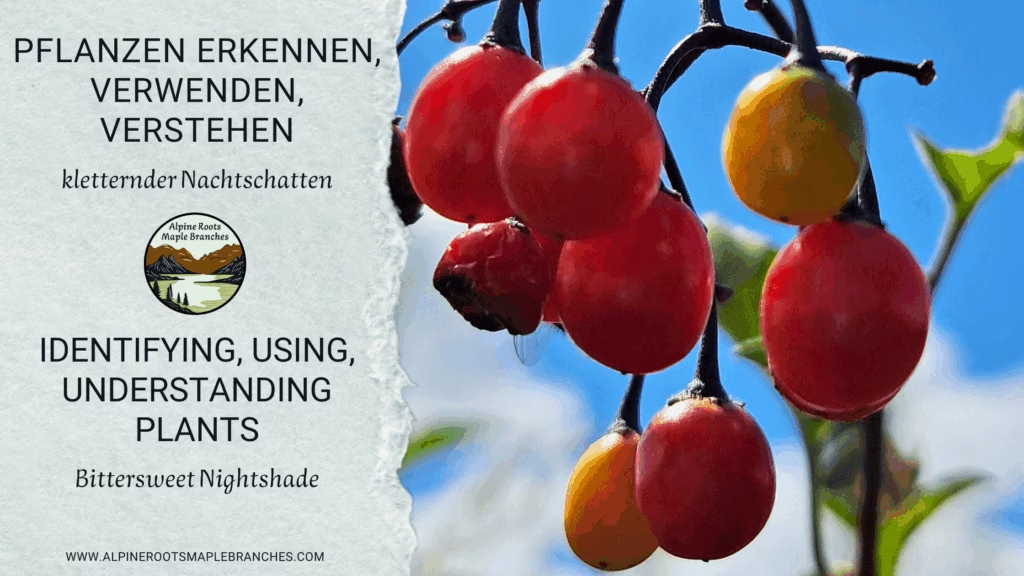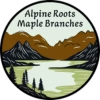
Bittersweet or Climbing nightshade is native to Eurasia and widespread in North America. It is a scrambling vine with purple-yellow, buzz-pollinated flowers and bright red berries. All plant parts are poisonous; unripe berries are the most hazardous. At the same time, the species provides ecological functions (cover/structure, pollen source, bird food) and should be managed case-by-case, especially along water edges.
Name
German: Kletternder Nachtschatten, Bittersüß
English: Bittersweet nightshade, Climbing nightshade
Latin: Solanum dulcamara L.
Plant group / family
Family: Solanaceae (nightshade family)
Subgroup: Solanum (nightshades)
Distribution
Original range: Europe and Asia
Current distribution: Widespread in Canada and the USA; listed as non-native in Canada. Occurs in swamps, along shores, moist edges, hedgerows, and other disturbed sites.
Identification
Height/length: Herbaceous climber; shoots to several metres (up to ~4 m) with support.
Leaves: Ovate, often with 0–2 narrow basal lobes.
Flowers: Star-shaped, purple to violet with conspicuous yellow anthers; mainly late spring through fall.
Fruits: Elliptic to egg-shaped berries, bright red at maturity, in loose clusters.
Stems: Basal portions become woody with age; climbing/prostrate habit.
Uses
Medicinal:
Historic folk uses are documented but not recommended due to toxicity. Reputable sources advise against medicinal use.
Culinary:
Not edible (all parts poisonous).
Ornamental:
Sometimes grown as an ornamental; not recommended because of toxicity and spreading habit.
Other (ecological functions)
- Pollen source for wild bees (buzz pollination; poricidal anthers).
- Cover/structure in hedges and moist margins; occasional nesting material/sites.
- Bird food: Ripe berries are eaten by some bird species; seeds are dispersed by birds. (Mammals are more sensitive.)
Toxicity
Poisonous parts: All parts, especially unripe (green) berries; main compounds are steroidal glycoalkaloids (e.g., solanine/solasonine/solamargine).
Symptoms: Nausea, vomiting, abdominal pain, diarrhoea; neurological signs possible at higher doses. Severe/intense exposures can occur; isolated serious cases are published.
First aid: If ingested or if unwell, contact Poison Control; call emergency services for severe symptoms. (For general glycoalkaloid thresholds see EFSA/OSU.)
Look-alikes
Similar species (all are poisonous; do not taste unless identification is certain):
- Black nightshade group (Solanum nigrum agg./S. americanum) – white flowers, berries black when ripe (small clusters). All parts potentially poisonous; leaves and unripe berries most risky.
- Deadly nightshade (Atropa belladonna) – solitary large black berries with a strongly enlarged calyx; different toxin class (tropane alkaloids). Extremely poisonous, severe poisonings documented.
Additional information
Care/management:
- In sensitive areas (shorelines, reforestation sites) reduce stands: pull young plants including roots, repeat checks; observe erosion control. If using herbicides, only permitted products/methods and check permissions near water. Wear gloves.
- In non-critical margins, “tolerate with guardrails” is possible (retain ecological functions but limit spread by thinning/un-twining; keep children/pets away). Agencies often rate overall impacts as low to moderate, yet recommend control where it competes with young woody plants or near water.
Growing conditions
Moist to fresh soils, partial shade to sun; common on disturbed ground and in riparian edge habitats.
Special notes
- Potential host/reservoir for solanaceous pathogens (reported regionally); use caution near agriculture.
- Very effective spread via seed (birds) and stem/root fragments.
Medical disclaimer
This information is for educational purposes only and does not replace advice from medical professionals. If poisoning is suspected, contact your local Poison Control centre immediately.
Passende Blogbeiträge
Sources
Sources
NC State Extension. plants.ces.ncsu.edu
FEIS (USDA FS). US Forest Service
ISCBC factsheet (PDF). bcinvasives.ca
King County PDF. your.kingcounty.gov
King County Seite. kingcounty.gov
USGS NAS. nas.er.usgs.gov
MISIN. learn.misin.msu.edu
WA DNR Rank (PDF). dnr.wa.gov
EFSA 2020. European Food Safety Authority
OSU EM9407 (PDF). extension.oregonstate.edu
